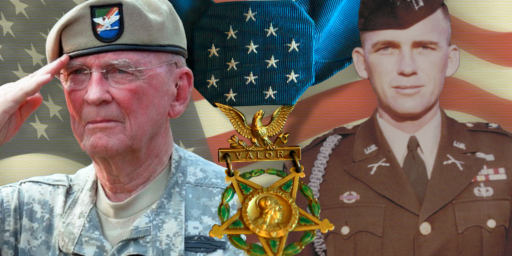U.S. Combat Fatality Rate Lowest Ever
U.S. Combat Fatality Rate Lowest Ever (Ceci Connolly, WaPo, A24)
Ten percent of soldiers injured in Iraq have died from their war wounds, the lowest casualty fatality rate ever, thanks in large part to technological advances and the deployment of surgical SWAT teams at the front lines, an analysis to be published today has found. But the remarkable lifesaving rate has come at the enormous cost of creating a generation of severely wounded young veterans and a severe shortage of military surgeons, wrote Atul Gawande, a surgeon at Brigham and Women’s Hospital in Boston.
The war in Iraq has produced the “largest burden of casualties our military medical personnel have had to cope with since the Vietnam War,” said Gawande’s report in the New England Journal of Medicine. By contrast, 24 percent of soldiers wounded in the Vietnam War or the Persian Gulf War did not survive. “It used to be our thinking that the number of deaths reflects the violence of the war,” Gawande said in an interview. “Now, the number of deaths reflects how well surgical teams are doing in saving lives.” More than 10,300 U.S. service members have been injured in Iraq and more than 1,000 of them killed in action, according to Defense Department statistics cited in the report. “This can no longer be described as a small or contained conflict,” Gawande wrote.
He praised the military’s strategy of positioning close to the fighting smaller, “leaner and more mobile” surgical teams with the ability to erect a battlefield hospital in less than 60 minutes. Traveling in Humvees with hand-held ultrasound machines, portable ventilators, supplies of red blood cells and an array of surgical tools and pharmaceuticals, the teams focus on stabilizing patients and moving them for further treatment in less than two hours.
During the Vietnam War, it took injured soldiers an average of 45 days to reach a hospital in the United States. At the beginning of the Iraq war, the average was eight days, and now it is four. One airman hit by a mortar attack in September “was on the operating table at Walter Reed” Army Medical Center here “just 36 hours later,” Gawande said. The battlefield triage is called “damage control” because the emphasis is on stopping bleeding, keeping a patient warm and leaving almost everything else to doctors at a permanent hospital. “The combination of Kevlar vests and a system that allows them to stop the bleeding makes it possible for them to survive injuries that were unsurvivable before,” he said. “How you rehabilitate physically, let alone emotionally, someone who has that kind of loss is a serious question.”
*** Col. John B. Holcomb, commander of the U.S. Army Institute of Surgical Research, agreed that Iraq can no longer be viewed as a minor conflict. But he said the casualty rate and severity of injuries is not inconsistent with other wars. A review of historical documents shows that “head and extremity injuries predominate, at least back to World War I, World War II, Korea and Vietnam,” he said. Perhaps Gawande, who lacks military experience, was unaccustomed to the level of trauma seen in war, Holcomb said. “The injuries in combat are devastating compared to what most civilian surgeons are used to seeing,” he said, adding that the closest parallel he could think of were injuries sustained by someone run over by a train.
Gawande’s credentials are impressive but I’m mystified that he finds the fact that we’re now able to save the lives of severely wounded soldiers to somehow be a bad thing. Our ability to return those like Lanier Ward to their families is nothing short of remarkable.





Maybe there’s more in the story, but I’m not getting a “boy, it would be better if they were dead” vibe from him, as you imply, he’s just outlining some of the consequences worth understanding.